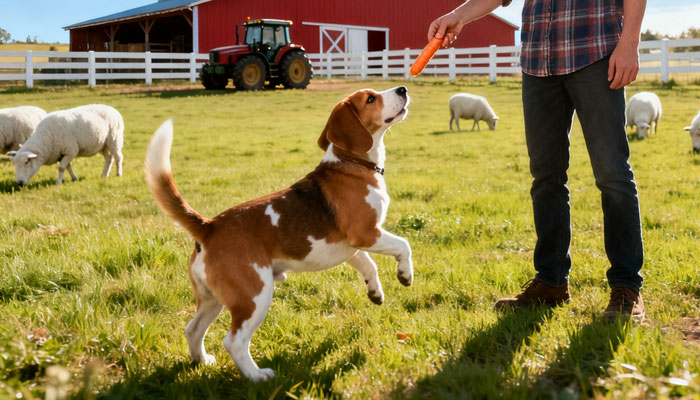The Developmental History of Beagles

The history of Beagles dates back to around 3000 years ago BC. It is tough to say exactly where and when these dogs came from, but a lot of evidence shows their close relationship to ancient hunting dog breeds. Some researchers believe their relatives might be from the ancient Egyptian dogs. Paintings and statues that look like modern Beagles found in the Egyptian tombs indicate that the breed’s family tree may have started back then.
I. The first sketches and names
Through the ages, these primitive hunting dogs were slowly taken over into the continent of Europe. Beagles were already used for small game hunting in antiquity Greece. According to the ancient Greek philosopher Xenophon’s work “On Hunting,” the small hounds that he described as using their sense of smell for locating and chasing hares are the first known written accounts of them. Later, at the time of the Roman Empire’s growth, these dogs were delivered to Britain and, hence, their coming of development in England was initiated.
In the 11th century William the Conqueror, by importing the Talbot hound from France, signaled an important evolution in the Beagle’s lineage. The characteristics of the modern Beagle were gradually being shaped by crossbreeds of the local hounds with the Talbot hound. During the Middle Ages, hunting turned out to be a very popular activity in Britain. While hares were eagerly hunted by nobles and landowners, the Beagle’s qualities of small size, speed, stamina, and, above all, tracking skills enabled it very quickly to become their perfect hunting partner.
They were especially loved by the British royal family. Queen Elizabeth I was very fond of a breed called the “pocket beagle,” a miniature hound that was so small that it could be transported in a pocket or a saddlebag making it very lovable. The Tudor dynasty (1485-1603) was the period when Beagles were at the zenith of their popularity among the British royal family. Along with Elizabeth I, members of the royal family like Prince William and George IV were also very passionate about them, not only as breeders but also taking them on their hunting trips. Bucks Palace turned into an over-the-top stronghold of Beagles.
II. Application as Laboratory Dogs
Once the Beagle’s gentle and manageable character was discovered, it followed the appearance of new utilizations. In 1950, the United States lobbied aggressively for the acceptance of the Beagle as a laboratory dog, which decision was influenced by multiple reasons. Beagles have a medium-sized body that makes them easy to accommodate and take care of; they have high disease resistance, are rather healthy, and keep good working conditions in the research locations; their genetic traits are stable, the number of hereditary neurological disorders is low, organ functioning is steady and body temperature is at a constant level, which enables experimental results to be repeatable and reliable. All these factors led to the rapid decision of Beagles as the best candidates for laboratory works. Later, various nations spread Beagles for their breeding programmes, which contributed to their designation as the standard dog breed for lifestudies around the globe. They are indispensable in medical, biological, pharmacological, and many other research fields.
III. Family Companion Animal
Society has changed considerably over the years, lifestyle changes have been very significant and hunting as a main activity is now over. The combination of a cute look with a seemly happy and spirited temperament was very quickly the key to Beagle’s widespread in households of the masses. They attach very deeply to their owners and love to be greeted at the door with loads of enthusiasm and gaiety thus being wonderful partners in the home environment. Their cry to the public is catchy and when trained well they can even be kept from calling at the times they become a nuisance no more. They are slowly turning from the past of hunting dogs into the present of companion animals.
Nowadays, Beagles are present in all corners of the earth. According to the statistics, there are as many as 100 000 Beagles all over the globe which take part in scientific research as well as being pets in countless families. Their lively images are very often seen in the parks of cities where they are free to run around and play with their owners who are usually very close by which makes for such a lovely sight of city life.
admin
-
Sale!

Washable Pet Cooling Pad for Cats and Dogs
$10.99Original price was: $10.99.$9.99Current price is: $9.99. This product has multiple variants. The options may be chosen on the product page -
Sale!

Washable Cat Window Hammock Cooling Bed
$23.99Original price was: $23.99.$22.99Current price is: $22.99. -
Sale!

Tropical Amphibian Rainforest Tank, Lizard Cage
$38.99Original price was: $38.99.$36.99Current price is: $36.99. -
Sale!

Silent 4-in-1 Waterproof Charging Dog Hair Trimmer
$49.88Original price was: $49.88.$47.99Current price is: $47.99.